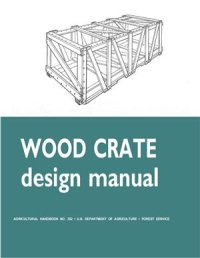
Ebook: Wood crate design manual
Author: Anderson L.O. Heebink T.B.
US / Forest products laboratory, 1964. — 134 c.The packaging industry consumes 15 to 20 percent of each years timber cut, in the form of lumber, plywood, veneer, container fiberboard, composite materials such as paper overlaid veneer, and papers of various types. Because of this continued heavy use of wood, the Forest Products Laboratory, U.S. Forest Service, has always devoted much research to packaging. Much of this research has been conducted over the years in cooperation with the Air Force, the Army Corps of Engineers and Ordnance Corps, other agencies of the Defense Department, and several industrial firms.
Of principal concern are the fundamental principles of design and the relationships of various details in the construction of containers that are balanced in strength. Special testing machines and methods of testing have been developed. From this research, supplemented by study and observation of shipping containers in service, has come much information of value to packaging engineers.
The growth of American industry has generated great needs for containers of all kinds, from colorful wraps for retail merchandise to workhorse containers for the worldwide shipment of machines and equipment of any size, shape, and weight. Among these containers, the wood crate is one of the most important used for shipping and is perhaps the most adaptable to the application of engineering principles in design. Crates are generally made of wood (or a wood-base material) because it is strong and rigid, comparatively light in weight, inexpensive, easily formed into a multitude of sizes and designs, and adaptable to a variety of conditions of use.
Of principal concern are the fundamental principles of design and the relationships of various details in the construction of containers that are balanced in strength. Special testing machines and methods of testing have been developed. From this research, supplemented by study and observation of shipping containers in service, has come much information of value to packaging engineers.
The growth of American industry has generated great needs for containers of all kinds, from colorful wraps for retail merchandise to workhorse containers for the worldwide shipment of machines and equipment of any size, shape, and weight. Among these containers, the wood crate is one of the most important used for shipping and is perhaps the most adaptable to the application of engineering principles in design. Crates are generally made of wood (or a wood-base material) because it is strong and rigid, comparatively light in weight, inexpensive, easily formed into a multitude of sizes and designs, and adaptable to a variety of conditions of use.
Download the book Wood crate design manual for free or read online
Continue reading on any device:

Last viewed books
Related books
{related-news}
Comments (0)